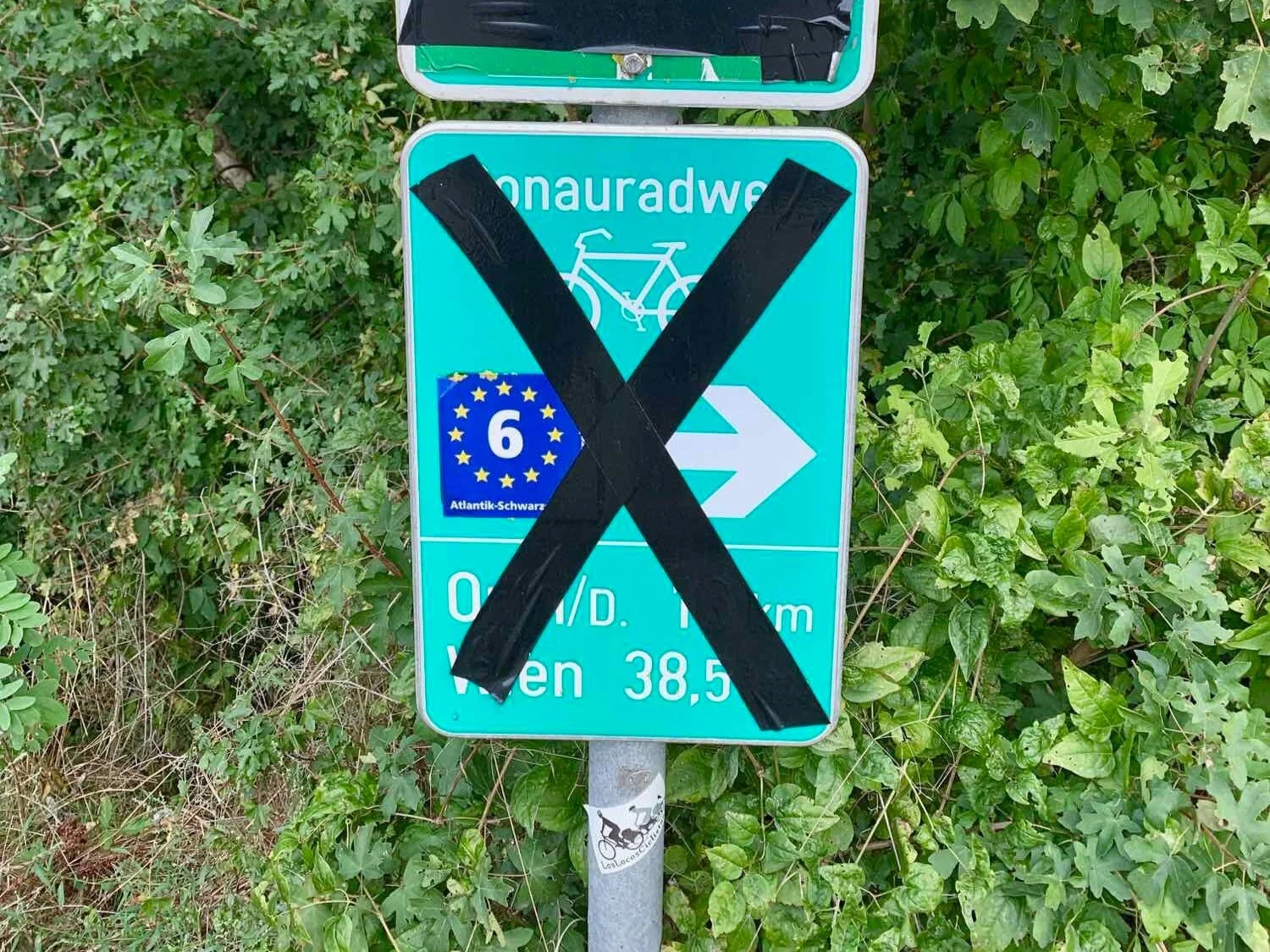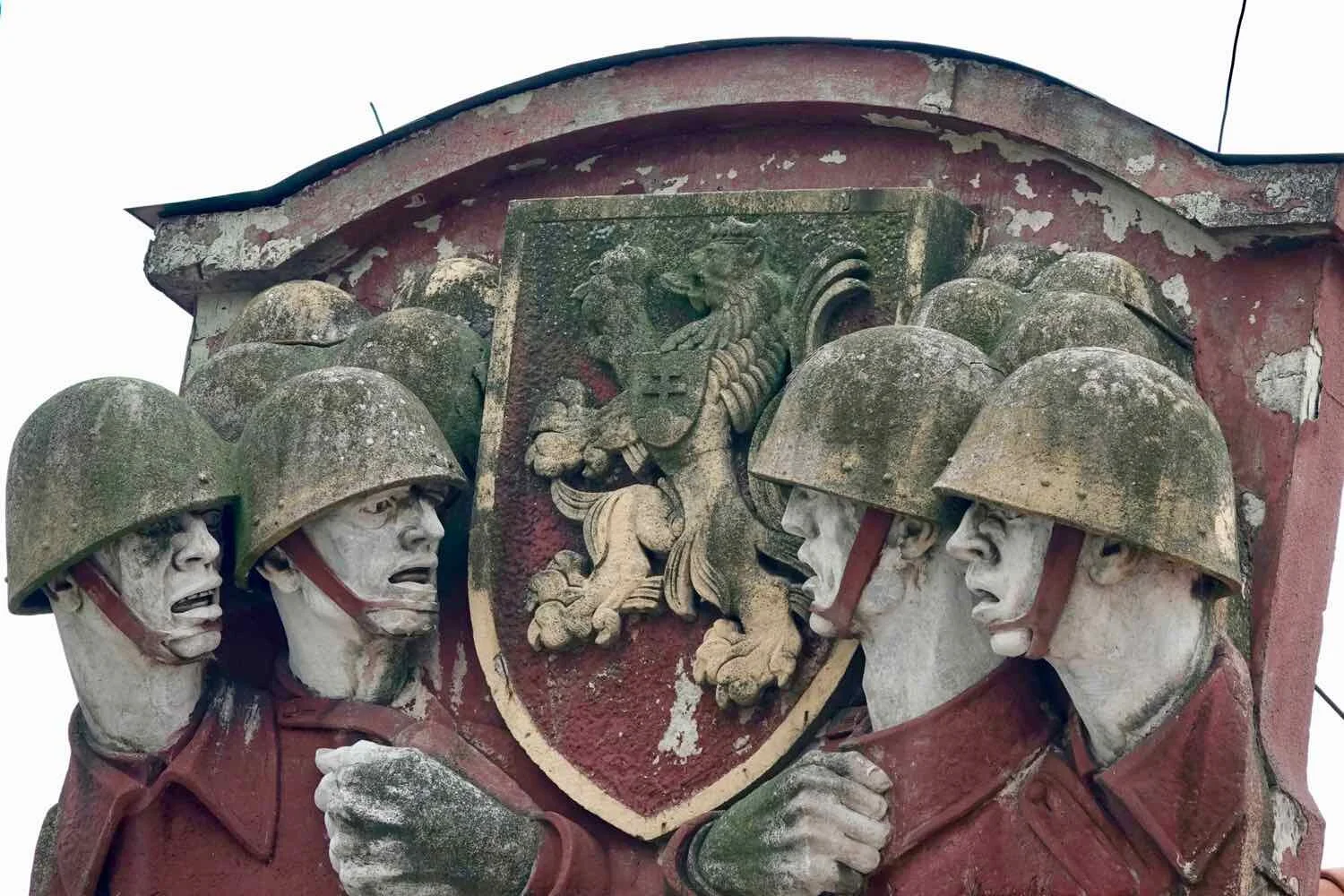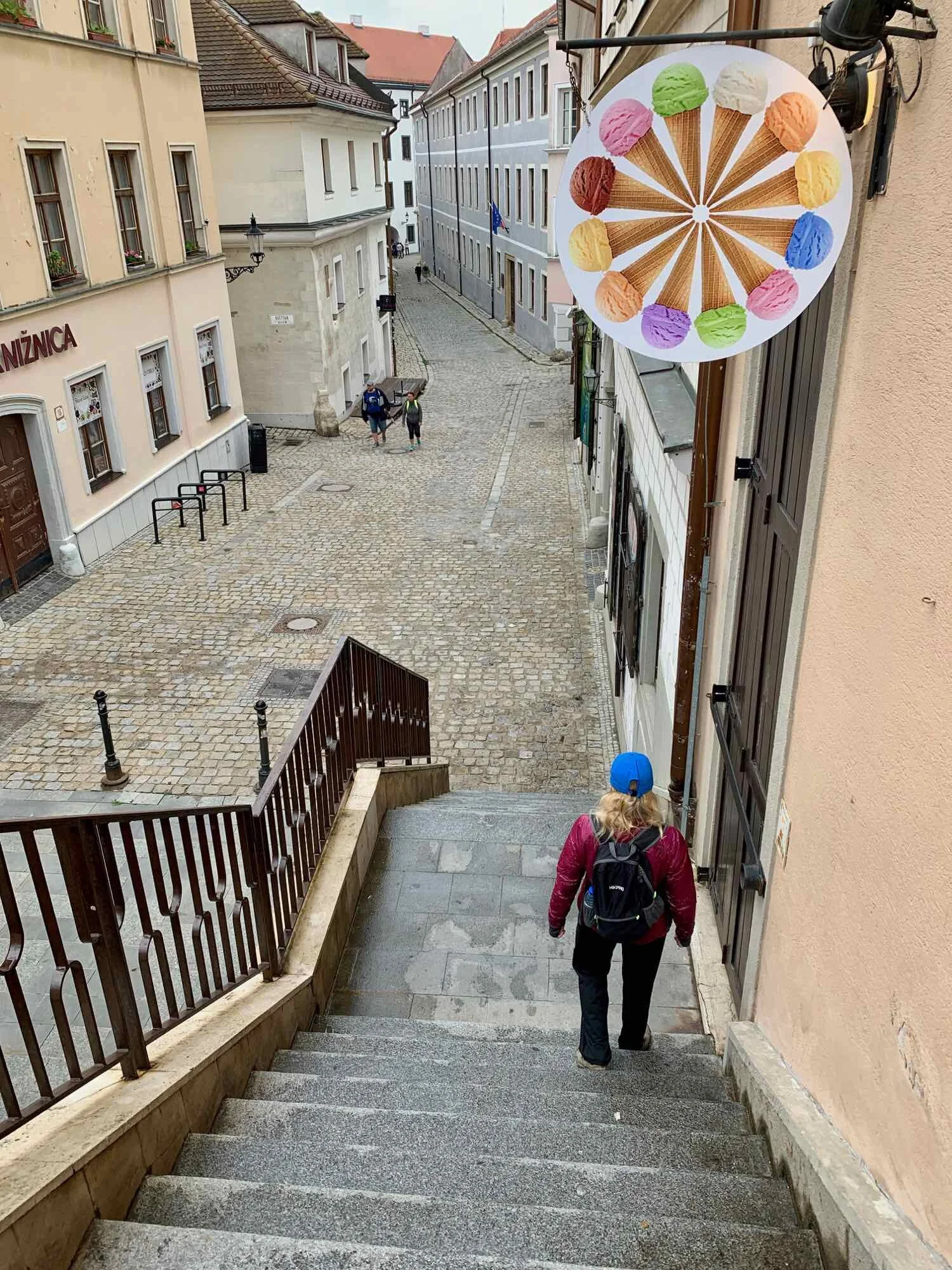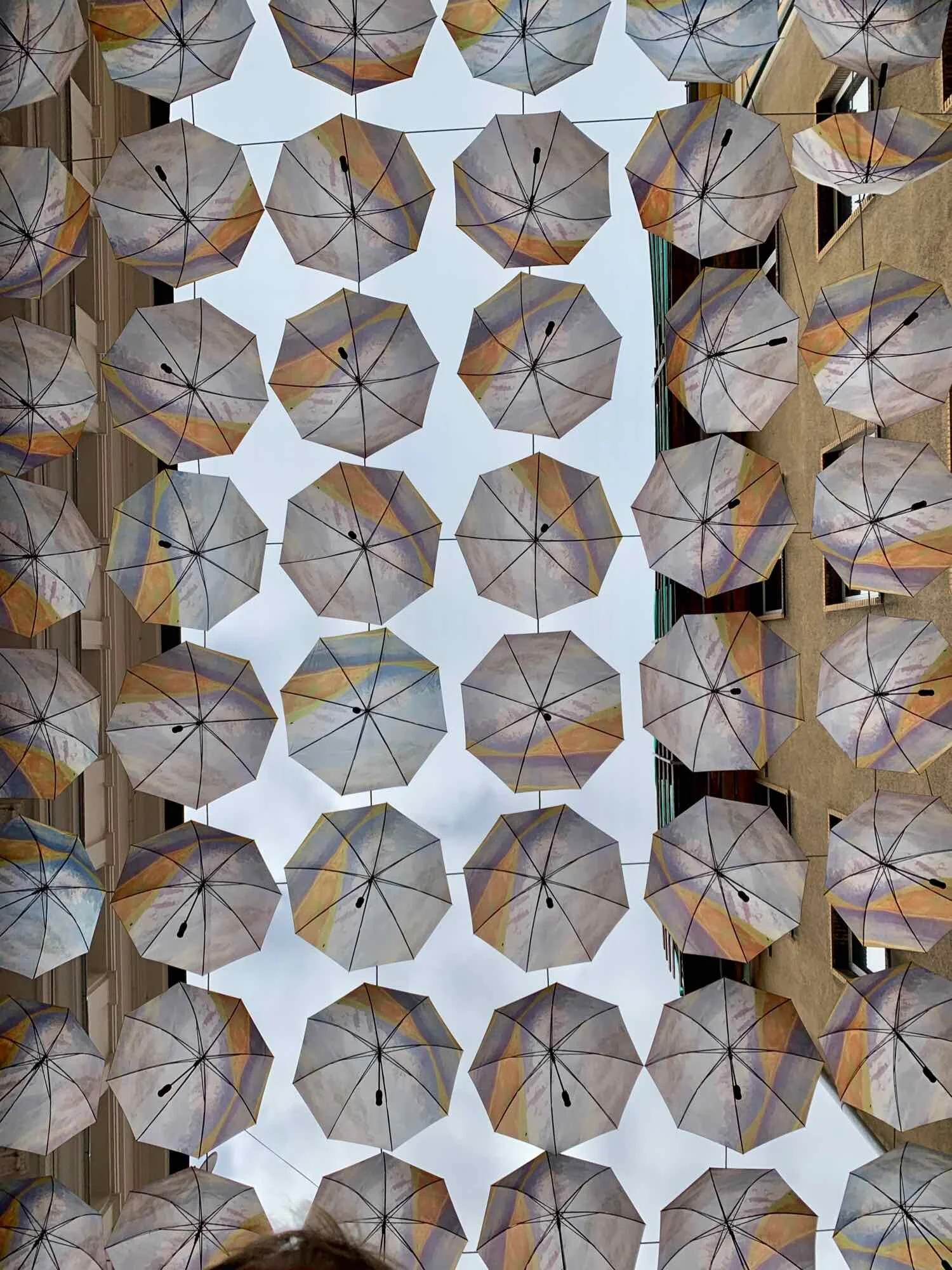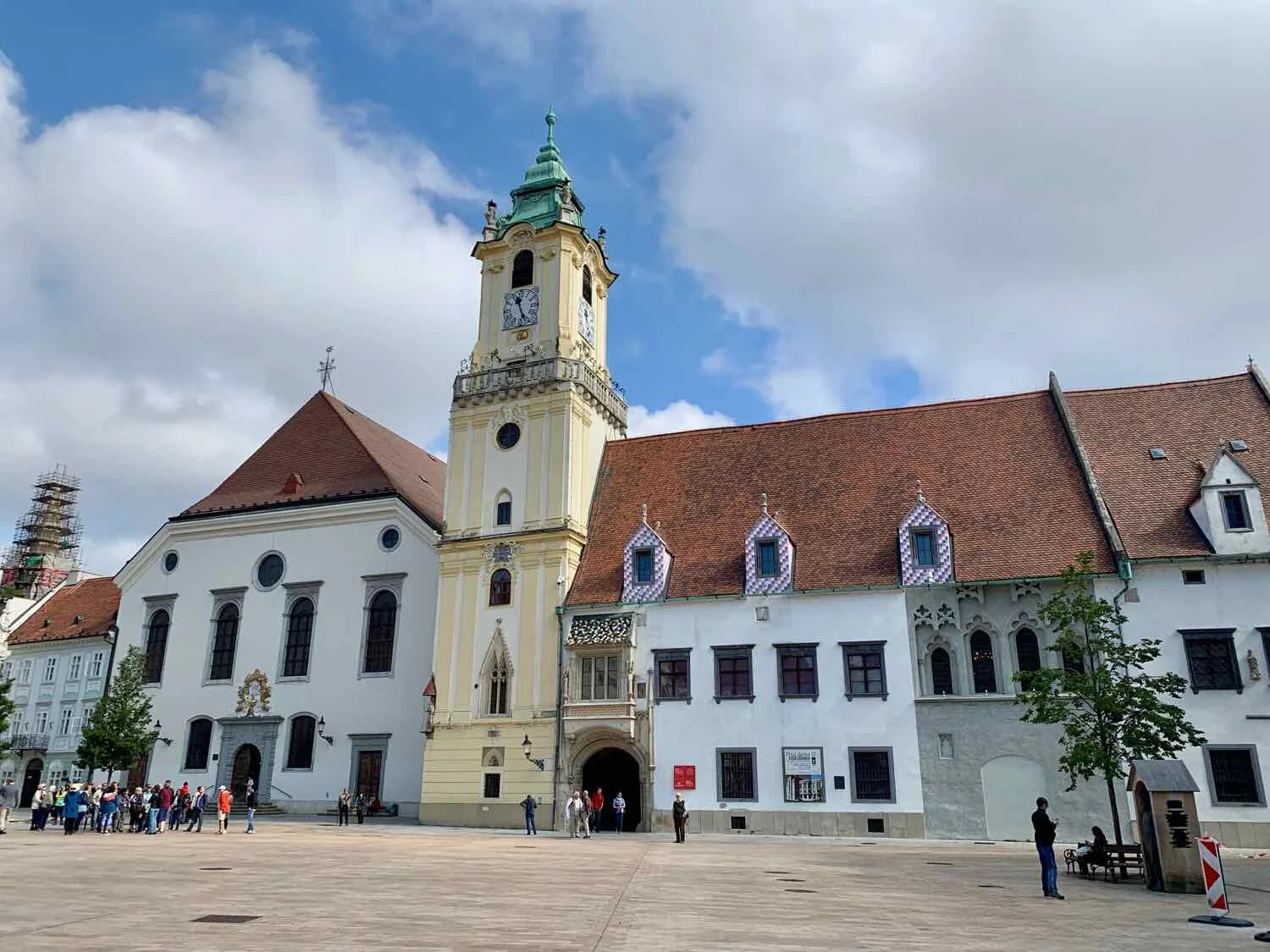Cycling Vienna, Austria to Bratislava, Slovakia: You (almost) Can’t Get There From Here
6 - 8 September 2019
Vienna, Austria to Bratislava, Slovakia (6 September 2019, 77.3 km, 48 mi)
We left Vienna early in the morning, to try to get out of the city before road traffic got too bad. Biking in Vienna can be pretty nerve-racking, even when the rare, dedicated bike lane is available. There’s a lot going on, with all of the cars, pedestrians, trams, and other bikes. Vienna has become a crazy, interlocking network of fast-moving vehicles that seemingly could run into you at any time. You really have to keep your wits about you to stay out of trouble.
Before striking out across the city on our bikes, we took some time to plot our strategy. PedalingGuy is looking at his phone, considering our route options to get back to EuroVelo 6. Based on the look on his face, it doesn’t look easy. Vienna, Austria. Copyright © 2018-2019 Pedals and Puffins.
Vienna is really two cities in one. On one side of the river is the old, traditional, Hapsburg Vienna. And on the other side is a set of relatively new, high-rise buildings anchored by one of the United Nations Headquarters.
When we made it safely across the Danube River we found ourselves surrounded by the “new” Vienna, in a canyon of high-rise buildings. We had breakfast at a bakery. But when we had finished eating, we couldn’t figure out how to get back onto the EuroVelo 6 route. We were only a short distance from where we needed to go, but we were surrounded by concrete and tall walls, on a platform high above the river, with no obvious way to ride or walk down to the cycle path below. We had to bike around in a somewhat helter-skelter, searching manner before we finally found a ramp down to the riverside.
We biked for more than 10 kilometers before the Vienna suburbs finally faded away, and we entered the Donau-Auen National Park.
At the far edge of Vienna’s suburbs, we passed the last signs of development as we rode by an industrial site with big chemical or petroleum tanks. The morning drizzle had ended, so we stopped to take off our rain gear. Vienna, Austria. Copyright © 2018-2019 Pedals and Puffins.
For most of the rest of the day, we biked through the national park, along levees that parallel the Danube River. The Donau-Auen National Park protects Europe’s most extensive, riparian wetland, but that was not always the case. In 1984, this stretch of the Danube was slated to be submerged under a reservoir by the building of a large, hydro-electric dam. Instead, public opposition scuttled the dam. And after additional scientific study, the area was determined to be worthy of national park status.
We passed a number of lovely ponds and wetland areas, inhabited mostly by herons, egrets and quite a few common buzzards. A giant green caterpillar (Convolvulus hawkmoth) rounded out our wildlife sightings. We kept our eyes open for some of those famous European pond turtles, but were not fortunate enough to see one.
We had some pretty crazy adventures related to the route, today. Right after we entered the national park, we started encountering gates set up to block the path along the levee, and signs saying No Bicycles. We saw other cyclists on the path - and there wasn’t an obvious detour - so we just found ways to get around the gates. That wasn’t very hard. But by the time we reached the fourth and fifth gates, it was starting to get weird, and annoying.
Then after passing the town of Stopfenreuth, at km 50, we hit a real snag. According to our map, we were supposed to leave the levee, and cycle up onto a bridge across the Danube. However, all of the access paths leading up to the bridge were blocked, with big imposing fences that would be impossible to get over. After looking around, we decided our only option was to maneuver around one of the barriers on a steep hill.
But even though it looked like other cyclists and pedestrians had gone around the barrier on a narrow, little path at the top, there was a very steep drop-off to our right. And the track curved sharply around the barrier, in a way that was not particularly suited for a fully-loaded touring bike. It was going to be very tricky to get the loaded bikes around that bend. We took them around, one at a time, carefully negotiating the bikes around the corner. It was a bit of a nail-biter, but we made it.
Maneuvering my bike around a barrier across the road. Engelhartstetten, Austria. Copyright © 2018-2019 Pedals and Puffins.
On the other side of the barrier we saw a big black “X” over the EuroVelo 6 sign. They clearly didn’t want bicycles going that way.
The weirdest thing of all was that, in spite of all the barriers, we couldn’t find any evidence of why cycling should be prohibited on the levees and the path up to the road. There wasn’t any construction going on, and the surfaces were in pretty good condition - not damaged by a storm or anything like that. There were just a bunch of man-made obstacles that seemed to serve no purpose.
Once we were on the bridge over the Danube, things got back to normal.
We decided to get lunch in the town of Hainburg an der Donau, at the far eastern end of Austria. The ride out of town was quite scenic as we passed through the Wienertor Gate, the largest medieval gate still standing in Europe. It was allegedly built using some of the ransom paid by England for the release of King Richard the Lionheart, after he had been imprisoned by Leopold V while on his way home from one of the Crusades.
Wienertor Gate in Hainburg an der Donau, Austria. Copyright © 2018-2019 Pedals and Puffins.
After lunch, it was only about 10 km further before we passed the former Iron Curtain border that used to separate Austria from communist Czechoslovakia (now Slovakia). What used to be a militarized and highly-guarded border is now completely open, with almost no indication that you are passing from one country into another. A symbolic blue gate remains to mark the border, but that’s it. And the gate’s always open.
Crossing over the Austria-Slovakian border, which was once heavily fortified and guarded. Now the symbolic blue gate is always open. Copyright © 2018-2019 Pedals and Puffins.
Since we do like to capture the moment when we cross into a new country, we also snapped a photo of a road sign, to prove we entered Slovakia. Copyright © 2018-2019 Pedals and Puffins.
Not long after crossing the border, we passed B-S 4, an old concrete bunker that was built in 1937 for the defense of Czechoslovakia. It now hosts a museum dedicated to preserving the history of the country’s pre-WWII fortifications. The interior has been restored to show what life was like for the soldiers who lived there.
The EuroVelo 6 route passes right by B-S 4, a concrete bunker that served as part of Czechoslovakia’s border protection system between the two world wars. The bunker now houses a military museum. Bratislava, Slovakia. Copyright © 2018-2019 Pedals and Puffins.
As we approached Bratislava, the capital of Slovakia, the landscape got more urban very quickly. We crossed the Danube into the old part of the city via the Most SNP bridge. That’s the one that has a restaurant and viewing platform way up on its main support arm. The tower gives the bridge an unmistakably unique profile, as well as a quirky kind of charm.
We stopped to photograph the Bratislava Castle, with its gleaming white walls and red roof at the top of the highest hill. As we stood on the bridge, we could feel the floor beneath us shaking and swaying with each passing car or truck. It didn’t seem like the strongest bridge, but it is beloved for it’s uniqueness. And it’s one of the longest of it’s kind.
Bratislava Castle, perched on the highest hill in town. In this case, the cathedral isn’t the most prominent building in the city. Bratislava, Slovakia. Copyright © 2018-2019 Pedals and Puffins.
Our hotel was way up on the hill, not that far from the castle. To get there, we ended up hiking straight up the cobblestone streets of the old city onto the castle hill. There was probably an easier route, but we didn’t have biking directions to follow, since Google doesn’t do biking directions in this part of the world. On the bright side, the walk through the medieval streets was very picturesque.
Our hotel was way up on the castle hill, with a view towards the old city. Peeking between the buildings, we could see the spire of the coronation cathedral. Eleven Hungarian kings and queens were crowned there. Bratislava, Slovakia. Copyright © 2018-2019 Pedals and Puffins.
Bratislava Rest Days (7-8 September 2019)
Bratislava’s old city is really beautiful, with quite a few sights to keep a traveler busy. We hung out for two days, enjoying the historic old buildings and cobblestoned alleys.
At the top of the highest hill, the view from the walls of Bratislava Castle is impressive. You get a feel for how big the city really is, beyond the old town. The metropolitan area is home to 650,000 people, and It extends across the Danube River to a huge area of dour, communist-era, high-rise buildings.
View of Bratislava from the walls of the castle. The Most SNP Bridge, which we crossed to enter the city, provides a dramatic foreground to the concrete block buildings beyond. Bratislava, Slovakia. Copyright © 2018-2019 Pedals and Puffins.
Bratislava has a vibrancy that you can feel in the streets of the old town. Much like Vienna, the city’s pedestrian areas are crowded with people browsing the shops and sitting in the outdoor cafes. We enjoyed walking through the maze of alleys, discovering interesting works of art and soaking up the 18th century ambiance.
Michael’s Gate, a 13th century entrance to the city. Bratislava, Slovakia. Copyright © 2018-2019 Pedals and Puffins.
How could we resist a restaurant that features a bicycle in its window? We ate at this wonderful, little Vietnamese restaurant two nights in a row. Bratislava, Slovakia. Copyright © 2018-2019 Pedals and Puffins.
Interestingly, English is widely spoken in Bratislava. We heard many people using English to speak with each other in the streets. We also appreciated the fact that more informational signs have English translations than in Germany or Austria. And many tour groups that we passed were being led by English-speakers.
And you couldn’t get away from the tour groups. They were absolutely everywhere. We got the feeling that many of them arrive by bus, or by the boats that cruise up and down the Danube.
There was one sight we wanted to see that took us out of the historic old town. The Church of St. Elizabeth is completely different from any other church we’ve seen. And it’s most unique feature is that everything about it is colored in a shade of blue. Even the parts that look almost white in photos are actually a very pale blue. The church is so fanciful in its design, that it almost looks like it was designed for a theme park. But the building is genuinely lovely, and it’s definitely worth the walk to go see it.
We enjoyed our time in Bratislava immensely. Memories of the city’s charm will stay with us for a long time.
